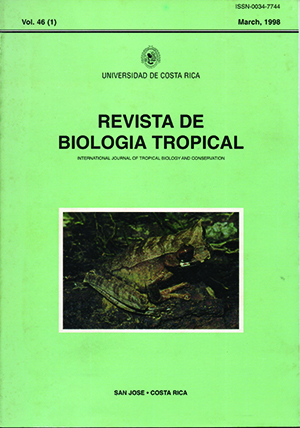Abstract
Natural hosts of four melon viruses (cucumber mosaie virus o CMV, papaya ringspot virus o PRSV, watermelon virus 2 o WMV -2 and zuechini yellow mosaic virus o ZYMV) were identified in two commereial melon farms in Costa Rica. The farms differed in management practices. Farm A had a long history of melon production in rotation with corn, sorghum and lice. Weed control was poor. Farm B was previously used as pastureland, had a shorter history of melon production, and was frequently plowed for weed control. Plant species diversity was monitored in 100 m' quadrants on each fanu over a one year periodo In addítion to the eultivated areas, four dístinet plant communíties (improved pasture field, drainage ditehes. secondary forest and fallow field) ín farm A, and ¡hree (spontaneus míxed species pasture field, fallow field and secondary forest) in farm B were included in the study. The number of quadrants sampled was dependent on the total eultivated area on eaeh farm. Five sampling dates were selected during rainy and dry ,easons and transition periods between ,easons. Plants of each species represented in the quadrants were colleeted at each sampling date and identified using referenee collections. Four plants of each species showing virus-like symptoms in the field were tested for the presence of the four viruses by ELlSA. The total number of plant species, and the pereent ground cover of eaeh species infected at least with one of the viruses were reeorded on eaeh of the five sampling dates. A total of 86 and 72 plant species were identified in sites A and B. respectively. Fourteen plant species. 16% of the total plant species represented in site A. and six species in site B (8%) were found to be infected with at least one of the four melon viruses at different times throughout the year. AII tour viruses were deteeted ín each location at each of the five sampling dates, indicatíng that weed species naturally oecurring in and around areas 01' eommercial melon production serve as reservoirs for the melon viruses and ensure the survival oflhe vifllses from one production season 10 the next. Several new host species of three of the melon viruses (PRSV, WMV -2 and ZYMV) were identified. Previously unreported hosts of PRSV included Tridax procumbens. Cleome viscosa. Cleome spi¡¡osa. Molvoviscus arboreus and Sida rhombif()/ia. New hosts of WMV-2 included C. viscosa, Crofum ar¡;el1leus. Musa I'ardisiaca and POJl.'eria heterol'hylla. New hosts of ZYMV included Guazuma ulmifólia, Rauvo!fia rerral'hylla, Malochra alceifólia, Boerhavia d!ffusa, p, heterophylla and C. viscosa.
Comments

This work is licensed under a Creative Commons Attribution 4.0 International License.
Copyright (c) 1998 Revista de Biología Tropical
Downloads
Download data is not yet available.






